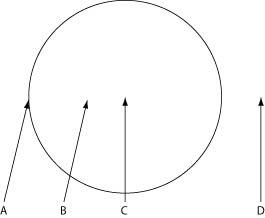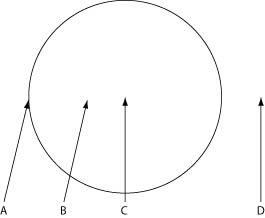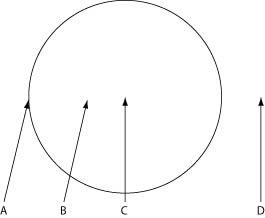Question 1
Which of the following cells or structures are associated with asexual reproduction in fungi?
a. ascocarps
b. zygosporangia
c. basidiospores
d. conidiophores
e. ascospores
d.
Question 2
Over human history, which process has been most important in improving the features of plants that have long been used by humans as staple foods?
a. pesticide and herbicide application
b. sexual selection
c. natural selection
d. artificial selection
e. genetic engineering
d.

Question 3
The following figure depicts the outline of a large fairy ring that has appeared overnight in an open meadow, as viewed from above. The fairy ring represents the furthest advance of this mycelium through the soil. Locations AD are all 0.5 meters below the soil surface. Responses may be used once, more than once, or not at all.
At which location should one find the lowest concentration of fungal enzymes, assuming that the enzymes do not diffuse far from their source, and that no other fungi are present in this habitat?
a. A
b. B
c. C
d. D
d.
Question 4
Which of the following statements correctly describes a portion of the pine life cycle?
a. Seeds are produced in pollen-producing cones.
b. A pollen tube slowly digests its way through the triploid endosperm.
c. Pollen grains contain female gametophytes.
d. Female gametophytes use mitosis to produce eggs.
d.
Question 5
In plants, which of the following are produced by meiosis?
a. diploid spores
b. haploid sporophytes
c. haploid spores
d. haploid gametes
e. diploid gametes
c.
Question 6
Which description does not apply equally well to both sexual and asexual spores?
a. are produced by meiosis
b. have haploid nuclei
c. represent the dispersal stage
d. upon germination, will subsequently undergo S phase and mitosis
a.
Question 7
How have fruits contributed to the success of angiosperms?
a. by producing sperm and eggs inside a protective coat
b. by attracting insects to the pollen inside
c. by nourishing the plants that make them
d. by facilitating dispersal of seeds
e. by producing triploid cells via double fertilization
d.
Question 8
Which of the following characteristics of plants is absent in their closest relatives, the charophyte algae?
a. alternation of multicellular generations
b. sexual reproduction
c. chlorophyll b
d. cellulose in cell walls
e. formation of a cell plate during cytokinesis
a.
Question 9
All fungi share which of the following characteristics?
a. heterotrophic
b. flagellated
c. pathogenic
d. act as decomposers
e. symbiotic
a.
Question 10
Which of the following conditions is caused by a fungus that is accidentally consumed along with rye flour?
a. ringworm
b. ergotism
c. athlete's foot
d. candidiasis (Candida yeast infection)
e. coccidioidomycosis
b.

Question 11
The following figure depicts the outline of a large fairy ring that has appeared overnight in an open meadow, as viewed from above. The fairy ring represents the furthest advance of this mycelium through the soil. Locations AD are all 0.5 meters below the soil surface. Responses may be used once, more than once, or not at all.
What is the most probable location of the oldest portion of this mycelium?
a. A
b. B
c. C
d. D
c.
Question 12
The Brazil nut tree, Bertholletia excels (n = 17), is native to tropical rain forests of South America. It is a hardwood tree that can grow to over 50 meters, is a source of high-quality lumber, and is a favorite nesting site for harpy eagles. As the rainy season ends, tough-walled fruits, each containing 825 seeds (Brazil nuts), fall to the forest floor. About $50 million worth of nuts are harvested each year. Scientists have discovered that the pale yellow, self-incompatible flowers of Brazil nut trees admit only female orchid bees as pollinators.
The agouti is most directly involved with the Brazil nut tree's dispersal of
a. male gametophytes.
b. female gametophytes.
c. sporophyte embryos.
d. sporophyte megaspores.
e. female gametes.
c.
Question 13
Among the organisms listed here, which are thought to be the closest relatives of fungi?
a. mosses
b. brown algae
c. animals
d. vascular plants
e. slime molds
c.
Question 14
What adaptations should one expect of the seed coats of angiosperm species whose seeds are dispersed by frugivorous (fruit-eating) animals, as opposed to angiosperm species whose seeds are dispersed by other means?
1. The exterior of the seed coat should have barbs or hooks.
2. The seed coat should contain secondary compounds that irritate the lining of the animal's mouth.
3. The seed coat should be able to withstand low pH's.
4. The seed coat, upon its complete digestion, should provide vitamins or nutrients to animals.
5. The seed coat should be resistant to the animals' digestive enzymes.
a. 3, 4, and 5
b. 4 only
c. 1 and 2
d. 3 and 5
e. 2 and 3
d.
Question 15
Which trait(s) is (are) shared by many modern gymnosperms and angiosperms?
1. pollen transported by wind
2. lignified xylem
3. microscopic gametophytes
4. sterile sporophylls, modified to attract pollinators
5. endosperm
a. 1, 2, and 3
b. 1 and 3
c. 1, 3, and 5
d. 2, 4, and 5
e. 1 only
a.

Question 16
The following figure depicts the outline of a large fairy ring that has appeared overnight in an open meadow, as viewed from above. The fairy ring represents the furthest advance of this mycelium through the soil. Locations AD are all 0.5 meters below the soil surface. Responses may be used once, more than once, or not at all.
Which location is nearest to basidiocarps?
a. A
b. B
c. C
d. D
a.
Question 17
Which event during the evolution of land plants probably made the synthesis of secondary compounds most beneficial?
a. the rise of wind pollination
b. the greenhouse effect present throughout the Devonian period
c. the association of the roots of land plants with fungi
d. the reverse-greenhouse effect during the Carboniferous period
e. the rise of herbivory
e.
Question 18
The Brazil nut tree, Bertholletia excels (n = 17), is native to tropical rain forests of South America. It is a hardwood tree that can grow to over 50 meters, is a source of high-quality lumber, and is a favorite nesting site for harpy eagles. As the rainy season ends, tough-walled fruits, each containing 825 seeds (Brazil nuts), fall to the forest floor. About $50 million worth of nuts are harvested each year. Scientists have discovered that the pale yellow, self-incompatible flowers of Brazil nut trees admit only female orchid bees as pollinators.
The agouti (Dasyprocta spp.), a cat-sized rodent, is the only animal with teeth strong enough to crack the hard wall of Brazil nut fruits. It typically eats some of the seeds, buries others, and leaves still others behind inside the fruit, which moisture can now enter. The uneaten seeds may subsequently germinate. Consequently, which terms describe the relationship between the Brazil nut tree and the agouti?
1. parasitic
2. commensalistic
3. symbiotic
4. endosymbiotic
5. mutualistic
a. 2 and 4
b. 2 and 5
c. 4 and 5
d. 1 and 3
e. 3 and 5
e.
Question 19
In addition to seeds, which of the following characteristics are unique to the seed-producing plants?
a. megaphylls
b. use of air currents as a dispersal agent
c. lignin present in cell walls
d. pollen
e. sporopollenin
d.
Question 20
When pathogenic fungi are found growing on the roots of grape vines, grape farmers sometimes respond by covering the ground around their vines with plastic sheeting and pumping a gaseous fungicide into the soil. The most important concern of grape farmers who engage in this practice should be that the
a. lichens growing on the vines' branches are not harmed.
b. fungicide might also kill the native yeasts residing on the surfaces of the grapes.
c. fungicide might also kill mycorrhizae.
d. sheeting is transparent so that photosynthesis can continue.
c.
Question 21
What do fungi and arthropods have in common?
a. The protective coats of both groups are made of chitin.
b. Both groups are predominantly heterotrophs that ingest their food.
c. Both groups are commonly coenocytic.
d. Both groups have cell walls.
e. The haploid state is dominant in both groups.
a.
Question 22
Which feature seen in chytrids supports the hypothesis that they diverged earliest in fungal evolution?
a. flagellated spores
b. formation of resistant zygosporangia
c. the absence of chitin within the cell wall
d. coenocytic hyphae
e. parasitic lifestyle
a.
Question 23
Which of the following is true of seedless vascular plants?
a. Sphagnum is an economically and ecologically important example.
b. Whole forests were dominated by large, seedless vascular plants during the Carboniferous period.
c. Extant seedless vascular plants are larger than the extinct varieties.
d. The gametophyte is the dominant generation.
e. They produce many spores, which are really the same as seeds.
b.
Question 24
Immediately after karyogamy occurs, which term applies?
a. heterokaryotic
b. dikaryotic
c. plasmogamy
d. diploid
d.
Question 25
When a mycelium infiltrates an unexploited source of dead organic matter, what are most likely to appear within the food source soon thereafter?
a. fungal haustoria
b. increased oxygen levels
c. larger bacterial populations
d. soredia
e. fungal enzymes
e.
Question 26
Which of the following flower parts develops into a seed?
a. fruit
b. stamen
c. ovule
d. ovary
c.
Question 27
Angiosperm double fertilization is so-called because it features the formation of
a. one embryo from one egg fertilized by two sperm cells.
b. two embryos from one egg and two sperm cells.
c. two embryos from two sperm cells and two eggs.
d. one embryo from two eggs fertilized by a single sperm cell.
e. one embryo involving one sperm cell and an endosperm involving a second sperm cell.
e.
Question 28
Which of the following is a land plant that has flagellated sperm and a sporophyte-dominated life cycle?
a. fern
b. charophyte
c. hornwort
d. liverwort
e. moss
a.
Question 29
Which of the following terms refers to symbiotic relationships that involve fungi living between the cells in plant leaves?
a. lichens
b. mycorrhizae
c. pathogens
d. endosymbioses
e. endophytes
e.
Question 30
Which of the following was not a challenge for survival of the first land plants?
a. sperm transfer
b. absorbing enough light
c. animal predation
d. desiccation
e. sources of water
c.
Question 31
The vegetative (nutritionally active) bodies of most fungi are
a. usually underground.
b. composed of hyphae.
c. referred to as a mycelium.
d. Three of these responses are correct.
e. Two of these responses are correct.
d.
Question 32
What is true of stamens, sepals, petals, carpels, and pinecone scales?
a. They are female reproductive parts.
b. None are capable of photosynthesis.
c. They are found on angiosperms.
d. They are modified leaves.
e. They are found on flowers.
d.
Question 33
Which of the following is true of the life cycle of mosses?
a. Spores are primarily distributed by water currents.
b. Antheridia and archegonia are produced by gametophytes.
c. The haploid generation grows on the sporophyte generation.
d. The growing embryo gives rise to the gametophyte.
e. The sporophyte generation is dominant.
b.
Question 34
With respect to angiosperms, which of the following is incorrectly paired with its chromosome count?
a. zygote–2n
b. megaspore–2n
c. sperm–n
d. microspore–n
e. egg–n
b.
Question 35
Lichens are symbiotic associations of fungi and
a. green algae.
b. mosses.
c. cyanobacteria.
d. Three of these responses are correct.
e. Two of these responses are correct.
e.
Question 36
What is true of charophytes?
a. They are the closest living algal relatives of land plants.
b. They are the ancestors of green algae.
c. They share some features in common with land plants, namely spores surrounded by sporopollenin and alternation of generations.
d. They are examples of seedless vascular plants.
a.